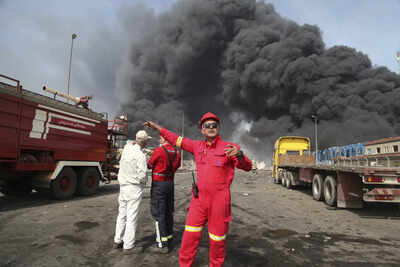
A huge blast and intense blaze at a crucial Iranian port in southern Iran has killed at least 18, with close to 800 other people injured, state media said on Sunday. The accident was at Shahid Rajaei port near the city of Bandar Abbas, and officials have been racing against time to hold back the ramifications.
"The fire is brought under control but not yet extinguished; the operation is ongoing," a state TV reporter said from the site, as dense black smoke poured out of the area.
The blast, which hit on Saturday, has been attributed to a cargo of ammonium perchlorate, a chemical employed in the manufacture of missile propellant. The cargo was received in March and formed part of a consignment from China to Iran, meant to resupply Iran's missile stores after it launched attacks on Israel during the conflict with Hamas in Gaza.
Helicopters and planes were deployed throughout the night into Sunday morning to put out the fire using water. Nonetheless, what ignited the deadly inferno has not yet been confirmed by the authorities. Video from social media at the scene showed dense reddish-colored smoke billowing from the blaze before the explosion, suggesting a chemical compound, similar to the 2020 Beirut port explosion, which was triggered by a stockpile of improperly stored ammonium nitrate.
In spite of the existence of such dangerous material, Iranian officials have not confirmed the details of the cargo. According to state news agency IRNA, a "pile of hazardous materials and chemicals" warehoused in the port area was to blame, but would not specify what chemicals were involved.
A potentially deliberate attack?
Though no official allegations have been made that the explosion was the work of an attack, Iran's Foreign Minister Abbas Araghchi admitted earlier this week that the nation is still on high alert because of previous attempts at sabotage designed to elicit a response. This might spark suspicions regarding potential outside interference, especially given Iran's tense relationship with Israel. In 2020, Israel was blamed for a cyberattack on Shahid Rajaei port, an indicator of the increased geopolitical tensions over the facility.
While no one has specifically blamed Israel for Saturday's blast, social media footage at the scene, and reports from local officials, indicate that the explosion was extremely forceful. Witnesses described glass breaking in buildings several kilometers from the epicenter of the explosion, and ambulances were spotted racing the injured to hospitals. A building collapse was also reported due to the explosion, though more information is still limited.
Environmental and public safety issues
As rescue teams struggle to contain the crisis, concerns about the environmental damage caused by the explosion are growing. The blaze has emitted toxic chemicals like ammonia, sulfur dioxide, and nitrogen dioxide into the atmosphere, with authorities issuing air pollution warnings for the area. Schools and offices in Bandar Abbas were closed on Sunday as a precaution to limit public exposure to the toxic fumes.
The blast also occurred at a timely moment in world diplomacy, with Iran and the United States in Oman negotiating the Tehran nuclear program's rapid progression. The blast has complicated the current negotiations but not directly by linking the two events.
A strategic port and past vulnerabilities
Shahid Rajaei port is an important transit point for Iran's cargo, on the strategically vital Strait of Hormuz, which facilitates about 20% of world oil commerce. The port has been struck previously, with a major cyberattack in 2020, which was claimed by Israel and momentarily halted its functions. Being one of the busiest ports in the region, the complex has also been the center of geopolitical tensions for a long time.
The fire and explosion have now focused international attention on the vulnerabilities of Iranian infrastructure, especially in relation to its missile programs and its controversial nuclear ambitions. The investigation into the accident is still under way, and Iranian leaders, including President Masoud Pezeshkian, have been quick to offer condolences to the victims.
As the investigation and cleanup continue, the extent of the damage may yet be revealed. The accident calls into question the safety and regulation of sensitive cargo at the port and the wider implications for the stability of the region, both politically and environmentally.

 1 month ago
17
1 month ago
17










 English (US) ·
English (US) ·